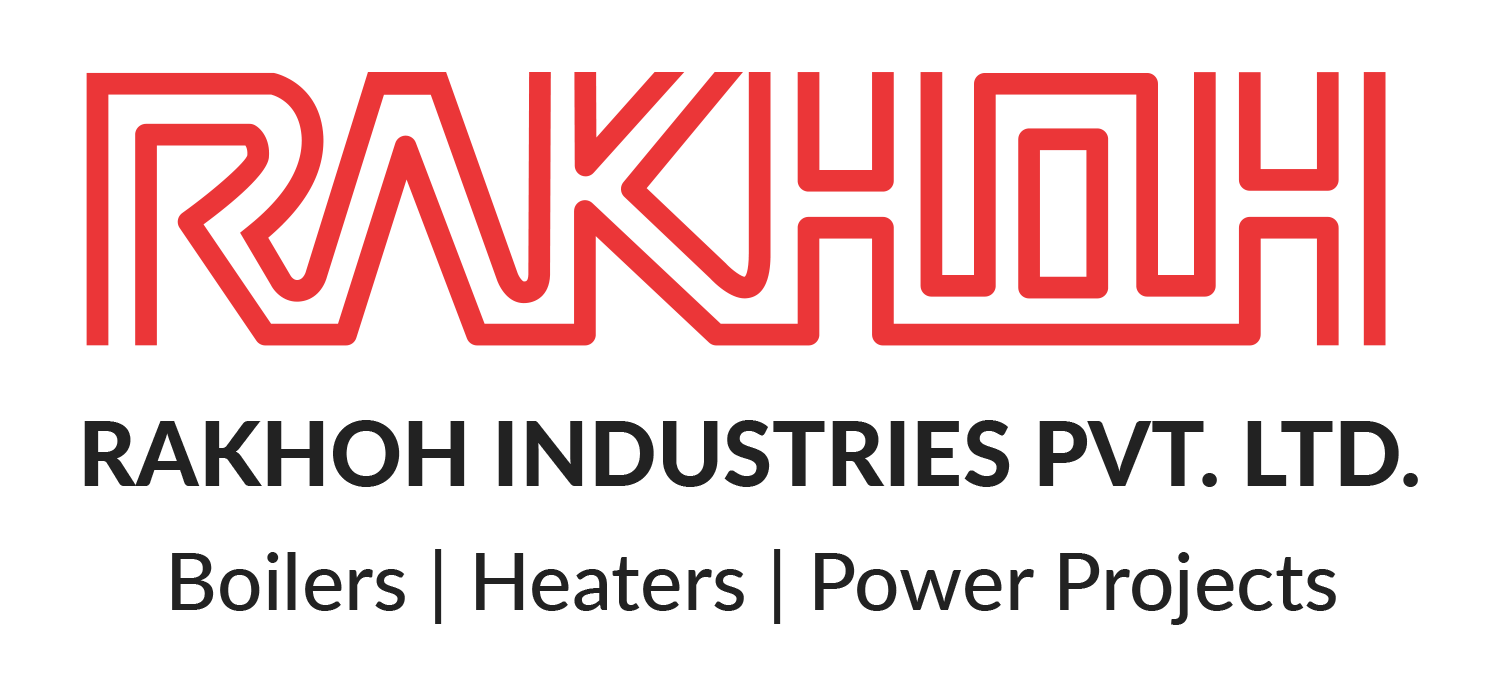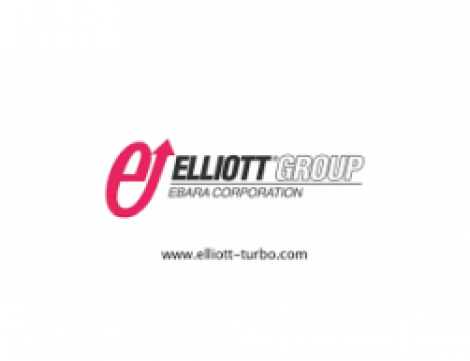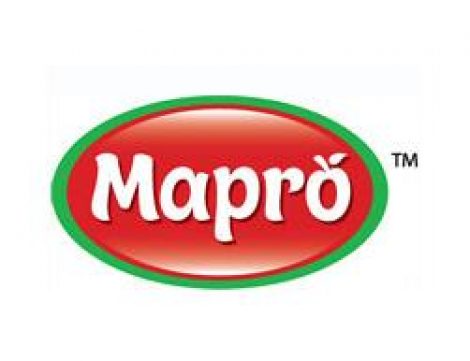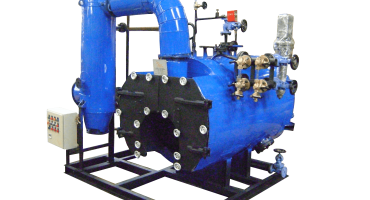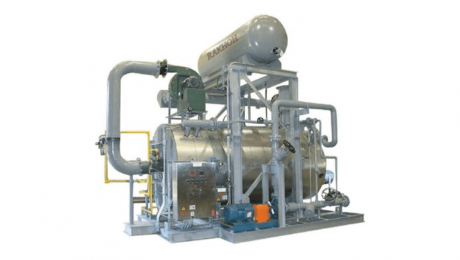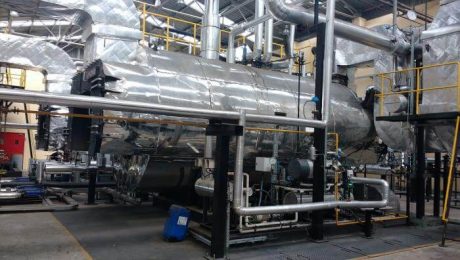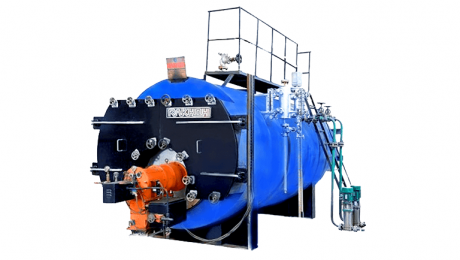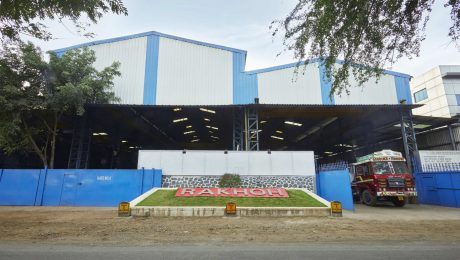Importance of Welding for Steam Boiler Manufacturing
Industrial steam boilers are irreplaceable in almost every industry throughout the world. The energy holding capacity and safety in using steam is a major cause of steam boilers being an ideal choice for process operations. Therefore, industries consider every factor while selecting a steam boiler manufacturer. The quality of the steam boiler is a crucial aspect in deciding on a boiler company. The precision and utilization of high-tech machinery play a vital role in ensuring the superior quality of steam boilers. A steam boiler is manufactured of three primary components i.e. a cylinder, a base, and a cover. Rakhoh Boilers, as a leading steam boiler manufacturer, ensures that the steam boilers are fabricated with utmost safety and precision with excellent welding.
Welding in Steam Boilers:
Welding is a process involving fabrication that joins materials, usually metals or thermoplastics, through fusion, varying from lower temperature metal-joining techniques like brazing and soldering that do not melt the base metal. Combined with melting the base metal a filler material is usually added to the joint, forming a pool of molten material to cool and form a joint. It is generally stronger than the base material. Pressure may also be used jointly with heat or by itself for producing a weld.
Contrary to brazing and soldering that do not involve the melting of base metal, welding includes a high heating process that melts the base material by usually adding filler material. As a result, the high heat causes a weld pool of molten material. Pressure is also used for producing a weld along with the heat or by itself. It also utilizes a shielding gas for protecting the melted and filler metals from contamination or oxidation. A weld joint in a steam boiler is designed for withstanding the subjected forces during its lifespan. Therefore, the design of the joint is decided by the type and load magnitude on the weld.
The welding process is generally categorized as:
Gas welding: Gas welding includes oxy-acetylene gas welding and hydrogen gas welding.
Arc welding: Arc welding includes metal arc welding (SMAW ), submerged arc welding (SAW ), gas metal arc welding (MIG, MAG), electrode slag metal arc welding, tungsten inert gas welding (TIG), flux-cored arc welding(FCAW ), etc.
Resistance welding: Resistance welding includes percussion welding, seam welding, and spot welding.
Thermit welding: Thermit welding involves producing heat by exothermic chemical reactions.
Solid-state welding: Solid-state welding involves friction welding, forge welding, pressure welding, etc.
Special welding process: Special welding processes include electron beam welding, diffusion welding, plasma arc welding, underwater welding, ultrasonic welding process, etc.
Requirements of Tube Welding in Steam Boilers:
The characteristics of boiler tube welding include,
The strength and consistency of the weld are pivotal considerations in determining the ideal way to weld the pressure vessel tubes as the tubes carry high-pressure steam or liquids in a flowing pattern that can cause a loss in efficiency due to turbulence or distortion.
One of the most crucial aspects of welding boiler tubes is to determine the ideal option between orbital welding and manual welding. Factors like industrial application tube quantity and safety should be the paramount priority. Therefore, manual welding is the least likely option because of the lack of accessibility.
Additionally, the welder must decide the best technique to apply. As gas-shielded welding processes are more consistent than other techniques, MIG and TIG are the ideal alternatives. However, MIG leads to the spattering of filler that negatively impacts the weld quality and bead appearance. On the other hand, TIG uses tungsten electrodes, producing the highest purity welds. Narrow Groove TIG or Thick Wall welding processes are best suited for the thick wall boiler applications found commonly in power plants.
Tungsten Inert Gas Welding with tungsten electrodes results in the highest-quality and consistent welds. Implementing an orbital welding process reduces the lack of accessibility, making it easier for consistency throughout the welding. However, attributes like good heat control, process stability, and fixed position tube welding capability with automated controls should be considered by steam boiler manufacturers for welding machines.
Common Hazards with Welding:
Welding leads to hazardous consequences for both welders and those working in the vicinity. Therefore, it is essential to ensure precautions to prevent accidents and injuries.
Electric Shock:
As a welder touches two metal objects with a voltage difference leads to the electric shock that can cause severe injuries or death. It is further classified as,
Primary shock:
It ranges from 230 to 260 volts that occur by having direct contact with the inside of welding equipment and other grounded metals. Primary shock is extremely hazardous
Secondary shock:
It is the most common type of shock occurring while touching the electrode circuit that ranges from 20 to 100 volts
Prevention for Electric Shock:
Fire Hazards:
Welding sparks spray up to 35 feet and may cause fire hazards, severely impacting the workers with grease on their clothing.
Prevention for fire hazards:
Fumes and Gases:
Welding introduces the personnel to gaseous fumes like ozone, nitrogen, and carbon monoxide that may cause asthma, pneumonia, or cancer.
Prevention for Fumes and Gases:
Physical Hazards:
Various physical hazards are involved in welding activities like burns, cuts, crushed fingers, and eye damage.
Prevention for physical hazards:
Conclusion:
Rakhoh Boilers is a leading steam boiler manufacturer since its inception in 1983. We are a trusted name in over 26 countries for delivering efficient steam boilers, waste heat recovery systems, thermic fluid heaters, boiler accessories, and boiler services of world-class quality.
For more details, visit www.rakhoh.com
- Published in Boiler, Steam Boiler
Importance of Heat Exchanger and Tips to Increase its Efficiency
Steam boilers are imperative for the operation of the process and manufacturing industries. Steam is vital for heating and processing purposes in industries, and therefore, a steam boiler consists of various components that ensure the steam generation takes place seamlessly. One such component in the boiler system is a heat exchanger. Heat exchangers are long tubes of metal with openings at both ends. It enables the heat transfer from the gas in the burners that produce toxic byproducts when it burns. Heat exchangers are not coils but are usually made from steel sheet metal and enable the gas-to-air exchange.
Importance of Heat Exchangers in Steam Boilers:
In a boiler system, the hot-water radiators harness heat from hot gas jets, but initially, the water needs to absorb the heat energy from the gas. The heat exchanger safely allows the passing of heat energy from gas to the water. If water is heated directly from the gas, the flames would be extinguished by the water. The basic principle of the heat exchanger is that it allows the transferring of the heat without transferring the fluid (liquid or gas) carrying the heat. The surfaces through which heat passes are called heat transfer surfaces. Heat transfer takes place in the steam boiler, where hot gasses from the combustion of fuel transfer levels of intense heat through the steam boiler tubes to produce steam.
The build-up of any hindering material such as scale, corrosion products, or micro-organisms on heat transfer surfaces slows down the heat exchange.
Indications of Issues in Heat Exchangers:
Several indicators point towards issues in heat exchangers and require prompt actions. Some of them are as follows,
Black Soot:
Black soot around the furnace is a clear sign that the gas is not burning properly. Unhealthy and incomplete combustion leads to dirty soot around the furnace. It usually leads to a damaged heat exchanger or an issue with the burner or furnace flame.
Unpleasant Smell:
Although gasses such as carbon monoxide are odorless, any strange or unpleasant odor near the furnace or air ducts requires professional attention. Cracked heat exchangers can leak combustion gasses into the boiler system that can cause a clear and present odor. In such situations, it is crucial to immediately turn off the heating system and seek professional help to diagnose the situation.
Water Surrounding the Furnace:
If water is found on the floor near the furnace, it may indicate a problem with the heat exchanger. Whether it is condensation or a cracked heat exchanger, seek professional help right away to determine the cause.
Outdated System:
If there are complaints of other aging problems with the furnace, such as wear and tear, loud noises, it is ideal to have a professional diagnose the entire steam boiler system.
How to Increase the Efficiency of the Heat Exchanger in Steam Boiler?
The ideal method to reduce the operating expenses in a process plant is by using and maintaining energy-efficient equipment
Reduce carry-over to avoid impurities and ensure proper levels of BTU content at end-use.
Impact of poor heat transfer in the steam boiler:
Conclusion:
Rakhoh Boilers are one of the leading manufacturers of industrial steam boilers in Pune since 1983. Over 38+ years, Rakhoh has successfully installed more than 3000 boilers in 26 countries worldwide. We also provide excellent boiler services like energy audit, boiler automation, steam trap assessment, annual boiler maintenance, fuel conversion, etc.
For more details on our products and services, visit www.rakhoh.com
- Published in Boiler, Steam Boiler
Priming and Foaming in Steam Boilers | Causes, Effects, and Prevention
The manufacturing and process industries throughout the world require steam boilers for processing operations. Steam boilers are undoubtedly irreplaceable equipment in the industries for heating, drying, and sterilization purposes. Plant managers ensure that the boiler systems are functioning smoothly and delivering optimum productivity. Regular maintenance and following standard guidelines are important to ensure the safety of the process plant and hassle-free operations. However, some boiler problems are inevitable and require prompt action to avoid significant losses or harm. Among many issues occurring in steam boilers, priming and foaming are the two most commonly found boiler problems. Let us understand both concepts in detail.
Priming:
As the steam boiler generates steam rapidly, some water particles are carried along with the steam. The process of formation of wet steam is known as priming. Due to the carryover of water droplets in the steam, the energy efficiency of the steam is reduced. It leads to salt crystals deposition on the superheaters and turbines. Improper construction of steam boilers, sudden fluctuation in steam demand, and excessive ratings are some of the primary causes of priming.
Minute drops entrainment is unavoidable in steam boilers. If the boiler water carryover is excessive, it results in steam-carried solids producing turbine blade deposits. The composition of the deposits is similar to the dissolved solids in the boiler water. Since priming is a major cause of the high level of boiler water carryover, it consequently leads to the failure of superheaters. Priming takes place due to the viscosity of water and its possibility of foaming. These properties depend on the alkalinity, presence of organic substances, and total dissolved solids or TDS. The level of priming is related to the design of the steam boiler and the steaming rate.
Priming leads to the deposit formation in the valves that causes overheating and corrosion in superheaters. It affects the heat transfer that results in low quality of processed product, higher level of steam consumption, and lowers the overall lifecycle of the steam boiler system.
Causes of Priming:
Effects of Priming:
Prevention for priming:
Ensuring chemical presence in the boiler water does not exceed the required amount
Foaming:
Foaming is the unrelenting formation of bubbles or foam in the steam boiler that does not cease easily. It is caused due to the oily substances in water that reduce the surface tension in the boiler water. The contamination of the steam with solids in boiler water causes water carryover. The froth or bubbles formed at the surface of the boiler passes out with the steam. The phenomenon, known as foaming, is caused by a high concentration of solids present in the boiler water. It has been found that particular substances such as alkalis, fats, oils, grease, and specific types of organic matter are specifically instrumental in foaming.
In addition, the suspended solids accumulated in the surface film that surrounds the steam bubble result in a persistent deposition. It leads to resistance in the bursting of a steam bubble that builds up foam. It has been observed that finer suspended particles accumulate on a higher level in the bubble.
Causes of Foaming:
Effects of Foaming:
Prevention of Foaming:
Introducing anti-foaming agents such as castor oil, tannic acid, gallic acid, etc.
Administrating compounds like sodium aluminate for eliminating oil from the boiler water
Since 1983, Rakhoh Boilers has emerged as a trusted boiler manufacturer in Pune, delivering efficient and reliable industrial steam boilers in over 26 countries globally. We manufacture superior quality products like steam boilers, waste heat recovery boilers, thermic fluid heaters, and boiler accessories. We are renowned for our excellent after-sales services like energy audit, boiler automation, steam trap assessment, annual boiler maintenance, etc., to ensure the hassle-free efficiency and productivity of the steam boilers.
To learn more about our products and services, visit www.rakhoh.com
- Published in Boiler, Steam Boiler
Daily Boiler Maintenance Practices For Industrial Boilers
Process and manufacturing industries with industrial boiler systems would understand the importance of seamless process operations for the industry’s overall success. At the same time, if industries aim to get the most out of the boiler system, it has to take care of it. That is why routine boiler maintenance is so essential. There are several important steps that plant managers need to perform every day if they plan to maximize the efficiency and longevity of the industrial boiler. Performing these simple steps can extend the boiler lifespan and schedule predictive boiler services before any major issues arise.
Daily maintenance is necessary to keep the boiler in good shape and ensure the safety of the process plant workers. Daily maintenance can prevent the build-up of soot and scale, both of which are harmful to the efficiency of the industrial boiler. Consequently, efficiency is critical for the boiler because equipment failures can be hazardous and usually result in a loss of productivity and revenue. In extreme circumstances, lack of boiler maintenance can lead to explosions, causing potential injury to personnel and extensive damage to the facility.
Boiler Maintenance Checklist For Daily Practices:
Inspect the Waterside
It is crucial to inspect the water components of the industrial boiler system. Industries regularly need to check for any mineral scale that might reduce the efficiency of the steam boiler. Any form of blockage within the pipes will impact the production levels. If it takes more energy for the boiler to push the hot water or steam, it is an indicator that the pipes are facing built up. Assess the tubes, furnace area, and gasket sealing surfaces. If the plants lack the tools to perform these inspections, ask for professional help who is well-equipped for these types of exams.
Inspect the Fireside and Burners
Process plant managers also need to inspect the fireside and burners. It is important to look for any signs that might reduce the efficiency of the industrial boiler. It is also necessary to check for any leakage that would call for repair. If there is a lot of soot, it indicates a larger problem. It is also vital to check the dampers, electrodes, novels, hoses, scanners, and diffusers. Plants are looking for any signs of blockage or erosion. If there are worn or damaged parts, it needs to be replaced immediately to optimize the efficiency of the boiler’s combustion processes.
Analyzing the Controls
It is also crucial to regularly analyze the controls. Proper water levels are critical for operational safety and optimal efficiency. Therefore, it is prudent to look for any signs of cracks or erosion. Plant personnel also need to inspect the equipment, taking a closer look at their output. In that way, it can be determined if something goes wrong. If one of the controls is not reading accurately, it indicates a deeper issue in the industrial boiler system. In such cases, the assistance of a reliable boiler manufacturer is advisable.
Visual Inspection for Cracks
Additionally, it is crucial to take a step back and do a visual inspection, checking for any signs of cracks. Even minor cracks can greatly reduce the efficiency of the industrial boiler, adding to the stress on the inner components. As a result, it can increase utility bills. If there are cracks, likely, metal parts are also damaged. While seeking professional boiler manufacturers to repair, make sure they utilize a high-quality patching compound. That way, these cracks do not return.
Ensure Routine Boiler Maintenance
Daily inspections are important when considering the return on investment for the industrial boiler. Even though it may seem that the boiler is operating properly, routine maintenance helps operators in identifying any signs of leaks, breaks, or other types of damage at the initial stage. If a loose screw is reducing performance output, the boiler system loses its efficiency. Such minor details are usually neglected but can significantly impact the boiler performance.
Furthermore, boiler maintenance can reduce utility expenses by maintaining production levels. If the industrial boiler requires more energy for generating the same target output, it indicates that the system is operating at a loss. Along with daily inspections, monthly boiler maintenance from a reliable boiler manufacturer ensures that the internal and external systems of the boiler are operating seamlessly. Consider the frequency, duration, and target output levels of the industrial boiler while developing a maintenance schedule.
Conclusion:
Rakhoh Boilers is one of the trusted boiler manufacturers in Pune since 1983. With 39+ years of experience and expertise in thermal solutions, we deliver highly efficient and reliable industrial steam boilers, waste heat recovery systems, thermic fluid heaters, and boiler accessories to over 20 process industries in 27 countries worldwide. We provide excellent boiler services to boost the efficiency and productivity of the boilers.
Visit www.rakhoh.com for more details on our products and services
- Published in Boiler, Steam Boiler
How Corrosion Can Lead to Failures in Steam Boilers
Combustion is an important process to generate steam in the process and manufacturing industries. The process includes burning various fuels that heat the water and produce steam. However, neglect in maintenance of the boiler system results in several boiler issues that can impact the efficiency of the process operations. One of the primary challenges of burning fuels is to manage the corrosion caused by the furnace heat transfer surfaces. Fireside corrosion is the major reason for failure in the superheater and reheater tubes. Boiler corrosion leads to outages and cases of tube failures of steam boilers in power plants. Not only power generation plants are affected by corrosion and failure of boilers, but any facility that uses steam boilers can face disruptions from corrosion damage.
What is Furnace Corrosion?
Fireside corrosion in the superheaters and reheaters is termed coal ash corrosion in coal-fired units, oil ash corrosion in oil-fired units, and ash corrosion in waste-recovery boilers. In some instances, fireside corrosion is also named hot corrosion. The mechanism in each scenario is similar, but the low-melting species in each differ. In coal ash corrosion, the low-melting substances are usually sodium or potassium iron trisulfate (Na3Fe(SO4)3 or K3Fe(SO4)3). In oil ash corrosion, it is usually V2O5-Na2O or V2O5-Na2SO4, and in waste heat-fired boilers, it is generally chlorides of iron and zinc, along with other possibilities. High temperatures above 1,000F of the superheater/reheater encourage the formation of these low-melting compounds.
The corrosion in coal ash corrosion ranging between 1,100F and 1,250F is very high. In such a temperature range, Na2SO4/K2SO4 reacts with surface oxides along with SO3 to form complex liquid sulfates (Na3Fe(SO4)3 or K3Fe(SO4)3) that cause corrosion.
The elements in oil ash corrosion include vanadium, sodium, potassium, and sulfur. The liquid fuel combustion generates low-melting species V2O5-Na2O, V2O5-K2O, V2O5-Na2SO4, and V2O5-K2SO4. Depending on the composition, the melting points of the compounds are between 1,000F and 1,550F. The oil ash corrosion is similar to coal ash corrosion with low-melting-point liquid forms and dissolves the protective iron oxides.
In waste-recovery boilers, chloride, and sulfate cause the formation of low-melting-point liquids on the tube surface that includes zinc, iron, lead, and sodium. It dissolves the protective iron oxide and brings the bare steel in contact with the corrosive environment, leading to significant wall loss. Lowering the conditions in the furnace results in the formation of iron sulfide rather than iron oxide. The carbon and iron sulfide present in the ash deposits indicate reducing conditions. Hydrogen chloride can impact iron sulfides instead of oxides to form iron chloride as a corrosion product. The iron chloride consists of a relatively low boiling point and forms vapors in the superheater/reheater temperature range. The corrosion mechanism is by the loss of iron as a vapor.
Furnace wall tubes are also impacted through fireside corrosion, but the low-melting elements differ from superheater/reheaters. Sodium and potassium pyrosulfate (Na2S2O7 or K2S2O7) causes the furnace wall corrosion. Both the elements melt below 800F, where the furnace wall tubes operate. The melting point of Na2S2O7 is 750F and of K2S2O7 is 570F. Combining the two compounds can melt at even lower temperatures.
Effects of Corrosion:
Lost Efficiency
Corrosion and scale deposits impact steam boiler efficiency. Even scale buildup as small as an eighth of an inch can reduce the efficiency.
Scale buildup contributes to more corrosion by trapping sodium under the scale, pitting the inside surface. It leads to further damage inside the boiler and its tubing. Holes in the metal result in leaks that cause severe operational problems and boiler shut down.
Shorter Lifespan
Overlooking corrosion reduces the lifespan of the steam boiler system. Corrosion increases with time if the water chemistry is neglected. The efficiency loss degrades until the system shuts down.
Higher Costs
Corrosion can lead to excessive costs for repairing the system or replacing damaged parts. In many cases, pitted tubes or parts need to be replaced rather than repaired. The system should be shut down to fix the damage that reduces productivity. Additionally, the downtime cuts into the operations and profits.
Holes
Holes occur while operating a system with severe pitting. The pits do not repair themselves or reverse their severity. It deteriorates as the chemical reaction that caused the erosion continues until the metal has a breech.
Pitting
Steam boilers having high levels of oxygen react with the metal to cause pits on the surface. If overlooked, the pits continue to deepen till they create holes in the metal. The holes can lead to the failure of the system.
Preventing Corrosion in Steam Boiler:
Monitoring the System
Maintaining the acid-base balance of the water is crucial to prevent acidity from damaging the steam boiler. Even with proper attention to the feedwater, there may be contaminants in the boiler itself. Monitoring the pH helps in determining when to blow down the system to remove contaminated water and reduce its impact.
The pH for feedwater is between 7 and 9, slightly alkaline. Sodium phosphate salts or sodium hydroxide are added to control the water within the range. However, the pH inside the heat of the boiler can be directly monitored and instead measured from a cooler, lower-pressure side stream.
Checking the water and steam for sodium also helps in preventing corrosion by determining the need to control the minerals present in the system.
Adjust Feedwater
Feedwater adjustment prevents the impact of dissolved oxygen on the metal surface of the system. Depending on the results, scavenging agents or added or a deaerator is used for getting rid of oxygen.
Three chemicals are common for scavenging oxygen
Conclusion:
Rakhoh Boilers is one of the trusted boiler manufacturers in Pune since 1983. With 38+ years of experience and expertise in thermal solutions, we deliver highly efficient and reliable industrial steam boilers, waste heat recovery systems, thermic fluid heaters, and boiler accessories to over 20 process industries in 26 countries worldwide. We provide excellent boiler services to boost the efficiency and productivity of the boilers.
Visit www.rakhoh.com for more details on our products and services
- Published in Boiler, Steam Boiler
